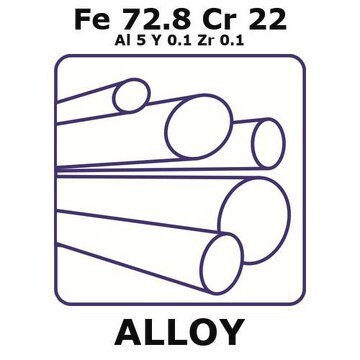GF21657472
Copper
wire reel, 5m, diameter 0.5mm, annealed, 99.9%
Synonim(y):
Copper, CU005280
Zaloguj sięWyświetlanie cen organizacyjnych i kontraktowych
About This Item
Wzór empiryczny (zapis Hilla):
Cu
Numer CAS:
Masa cząsteczkowa:
63.55
Numer MDL:
Kod UNSPSC:
12141711
Identyfikator substancji w PubChem:
NACRES:
NA.23
Polecane produkty
Próba
99.90%
Postać
wire
producent / nazwa handlowa
Goodfellow 216-574-72
rezystywność
1.673 μΩ-cm, 20°C
dł. × śr.
5 m × 0.5 mm
tw
2567 °C (lit.)
mp
1083.4 °C (lit.)
gęstość
8.94 g/mL at 25 °C (lit.)
ciąg SMILES
[Cu]
InChI
1S/Cu
Klucz InChI
RYGMFSIKBFXOCR-UHFFFAOYSA-N
Powiązane kategorie
Opis ogólny
For updated SDS information please visit www.goodfellow.com.
Informacje prawne
Product of Goodfellow
This page may contain text that has been machine translated.
Kod klasy składowania
13 - Non Combustible Solids
Klasa zagrożenia wodnego (WGK)
WGK 2
Temperatura zapłonu (°F)
Not applicable
Temperatura zapłonu (°C)
Not applicable
Certyfikaty analizy (CoA)
Poszukaj Certyfikaty analizy (CoA), wpisując numer partii/serii produktów. Numery serii i partii można znaleźć na etykiecie produktu po słowach „seria” lub „partia”.
Masz już ten produkt?
Dokumenty związane z niedawno zakupionymi produktami zostały zamieszczone w Bibliotece dokumentów.
Julie E Gleason et al.
Proceedings of the National Academy of Sciences of the United States of America, 111(16), 5866-5871 (2014-04-09)
The human fungal pathogens Candida albicans and Histoplasma capsulatum have been reported to protect against the oxidative burst of host innate immune cells using a family of extracellular proteins with similarity to Cu/Zn superoxide dismutase 1 (SOD1). We report here
Alina Fedoseienko et al.
Annals of the New York Academy of Sciences, 1314, 6-14 (2014-04-05)
Copper is an important cofactor in numerous biological processes in all living organisms. However, excessive copper can be extremely toxic, so it is vital that the copper level within a cell is tightly regulated. The damaging effect of copper is
L Marchand et al.
Environmental pollution (Barking, Essex : 1987), 193, 205-215 (2014-07-25)
Intra-specific variability of root biomass production (RP) of six rooted macrophytes, i.e. Juncus effusus, Phragmites australis, Schoenoplectus lacustris, Typha latifolia, Phalaris arundinacea, and Iris pseudacorus grown from clones, in response to Cu exposure was investigated. Root biomass production varied widely
Adam Southon et al.
Metallomics : integrated biometal science, 5(10), 1346-1356 (2013-08-02)
Copper (Cu) is an essential redox active metal that is potentially toxic in excess. Multicellular organisms acquire Cu from the diet and must regulate uptake, storage, distribution and export of Cu at both the cellular and organismal levels. Systemic Cu
Giulia Cheloni et al.
Aquatic toxicology (Amsterdam, Netherlands), 155, 275-282 (2014-07-30)
The present study showed the important role of light intensity and spectral composition on Cu uptake and effects on green alga Chlamydomonas reinhardtii. High-intenisty light (HL) increased cellular Cu concentrations, but mitigated the Cu-induced decrease in chlorophyll fluorescence, oxidative stress
Nasz zespół naukowców ma doświadczenie we wszystkich obszarach badań, w tym w naukach przyrodniczych, materiałoznawstwie, syntezie chemicznej, chromatografii, analityce i wielu innych dziedzinach.
Skontaktuj się z zespołem ds. pomocy technicznej




